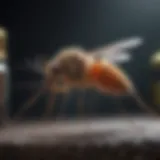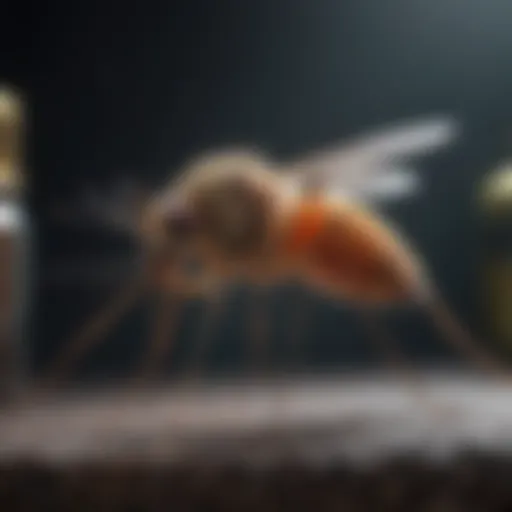Unveiling the Intricate World of Reproductive Termites: Anatomy, Mating Rituals, and Colony Dynamics


Preventive Pest Control Strategies
House Exterior Protection
When it comes to preventing pest infestations, focusing on safeguarding the exterior of your house is paramount. Begin by meticulously sealing any cracks or openings that may serve as entry points for pests. Utilize high-quality sealants to ensure a thorough job. Clearing debris such as leaves, twigs, and clutter from around your home's perimeter is crucial in eliminating hiding spots for pests. By maintaining a meticulously clean exterior, you can significantly deter pests from entering your home.
Yard Maintenance
Maintaining a well-kept yard is a fundamental aspect of pest control. Establish essential yard care routines that include regular mowing, trimming vegetation, and pruning bushes. By keeping your yard tidy and free of overgrowth, you create an environment that is less appealing to pests. Implement methods such as removing standing water and maintaining proper drainage to prevent water accumulation, which can attract pests like mosquitoes.
Indoor Cleanliness
Indoor cleanliness is key to deterring pests from taking up residence in your home. Employ expert cleaning tips and techniques that focus on areas prone to pest activity, such as kitchens, bathrooms, and storage spaces. Regularly vacuuming, dusting, and decluttering can significantly reduce the likelihood of pests finding harborage within your home. Additionally, sealing food containers and properly storing pantry items can thwart pests seeking a food source.
Garbage Disposal
Efficient waste disposal is essential in preventing pest infestations. Deploy proper garbage disposal methods by securely bagging all trash and promptly placing it in sealed bins. It is crucial to remove trash regularly to prevent odors that may attract pests. Emphasize the importance of proper garbage disposal to all household members to maintain a pest-free environment.
Other Pest Prevention Strategies
Innovative pest prevention strategies can further fortify your home against potential infestations. Consider implementing additional measures such as installing door sweeps, using mesh screens on windows, and sealing gaps around utility pipes. These proactive steps add layers of protection to your pest control efforts, bolstering your home's defenses against intrusive pests.
Introduction
Understanding Termites
The role of termites in ecosystems
When examining the role of termites in ecosystems, their profound impact on soil composition and nutrient recycling comes to light. Termites act as nature's engineers, breaking down organic matter and enhancing soil fertility. Their ability to decompose cellulose-rich material sets them apart, making them vital contributors to ecosystem health. This distinctive trait makes them a popular subject for research, shedding light on the delicate balance they uphold within their habitats.
Distinct castes in a termite colony
Termites manifest a hierarchical society with distinct castes, each playing a specialized role. From workers diligently tending to tasks, soldiers fiercely protecting their colonies, to reproductives ensuring the colony's future, the division of labor is striking. This caste system fosters efficiency and survival, showcasing the intricate dynamics at play within a termite community. However, it also poses challenges, such as potential conflicts or resource allocation disparities, underscoring the complexity of termite social structures.
Focus on reproductive termites
Focusing on reproductive termites illuminates their pivotal function in colony perpetuation. These individuals, comprising the king, queen, and alates, oversee the colony's reproduction and expansion. Their unique reproductive abilities and behaviors sustain the termite population, ensuring its longevity and genetic diversity. Exploring the reproductive termites' world unveils a realm teeming with strategies for colony survival, evolution, and adaptation, demonstrating the evolutionary prowess embedded in these specialized members.
Importance of Reproduction
Propagation of the colony
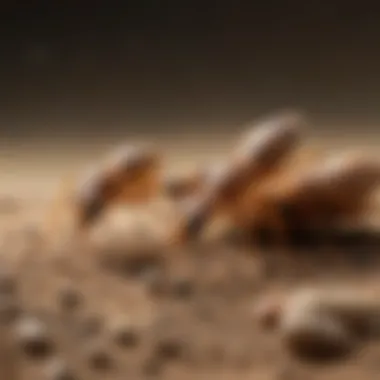

The propagation of the colony centers on reproductive termites' vital role in establishing and growing termite populations. Through the queen's prolific egg-laying capability and the concerted efforts of king termites to fertilize eggs, colony size is maintained and expanded. This process not only secures immediate survival but also fortifies genetic resilience, enabling colonies to withstand environmental pressures and challenges effectively. The propagative aspect of termite reproduction underscores the critical nature of reproductive success in colony sustainability.
Genetic diversity benefits
Genetic diversity among termite colonies confers essential adaptive advantages, enhancing their resilience to fluctuating environmental conditions and threats. By incorporating genetic variability through processes like recombination and outbreeding, termites optimize their gene pool, promoting colony fitness and long-term viability. This genetic diversity serves as a buffer against extinction risks and promotes adaptability, enabling colonies to thrive amidst changing landscapes and ecological conditions.
Purpose of the Article
Exploring the reproductive termites' world
Engaging in a comprehensive exploration of the reproductive termites' world sheds light on their evolutionary strategies, reproductive mechanisms, and ecological significance. This journey unravels the mysteries of termite reproduction, unveiling intricate behaviors, and adaptations that underpin colony success. By meticulously dissecting the reproductive termites' realm, this article aims to offer a nuanced understanding of their pivotal role in sustaining termite colonies and shaping ecosystem dynamics.
Highlighting the significance within a termite colony
Highlighting the significance of reproductive termites within a termite colony underscores their irreplaceable contributions to colony establishment, growth, and maintenance. Their role in fostering genetic diversity, ensuring reproductive success, and perpetuating termite populations is paramount. By emphasizing their significance, this article aims to showcase the indispensable nature of reproductive termites in the larger tapestry of termite societies, enriching our comprehension of these remarkable insect communities.
Anatomy of Reproductive Termites
The anatomy of reproductive termites plays a pivotal role in understanding the complexity of termite colonies. By delving into the specific elements of reproductive termites' anatomy, we can unravel the benefits and considerations surrounding their vital functions within the colony. From the physiological structures that enable reproduction to the intricate mechanisms that sustain the colony, the anatomy of reproductive termites serves as a cornerstone in the ecosystem.
Queen Termite
Egg-laying prowess
The egg-laying prowess of the queen termite is a remarkable aspect of their reproductive capability. With the ability to lay thousands of eggs daily, the queen termite ensures the colony's propagation and sustainability. This key characteristic of egg-laying prowess is paramount in maintaining the termite population and colony growth. Despite its significance, the constant demand for egg production can also impose a physical strain on the queen, affecting her longevity and health.
Physical characteristics
The physical characteristics of the queen termite are tailored to support her reproductive role within the colony. From her enlarged abdomen for egg storage to her robust exoskeleton for protection, these attributes are essential for her survival and success. The unique feature of the queen's physical build enables her to endure the demands of continuous egg-laying while safeguarding her from external threats. However, her immobility and dependency on the colony for sustenance could be considered as potential disadvantages in certain scenarios.
King Termite
Contributions to the colony
The king termite's contributions to the colony extend beyond reproduction, encompassing roles in defense and colony maintenance. His involvement in guarding the queen and the nest, along with participating in nest-building activities, solidifies his importance within the termite community. This key characteristic of the king's multifaceted contributions ensures the overall well-being and functionality of the colony, highlighting his irreplaceable value. Nevertheless, the king's limited reproductive role compared to the queen may pose challenges in terms of genetic diversity and adaptation.
Reproductive role
The reproductive role of the king termite revolves around mating with the queen to fertilize her eggs, thereby contributing to the colony's offspring. This essential function reinforces the genetic diversity within the colony, enhancing its adaptive capacity and resilience. The king's unique feature lies in his exclusive genetic lineage preservation, which serves as a critical element in maintaining the colony's vitality. However, the limited number of mating opportunities for the king could be considered a potential disadvantage in terms of reproductive efficiency.
Alates
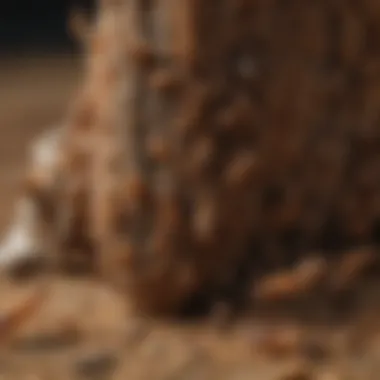

Winged reproductive termites
Alates, or winged reproductive termites, represent the future of the colony through their potential to establish new colonies via dispersal. Their key characteristic of possessing wings enables them to participate in nuptial flights and locate suitable sites for new colonies. This distinctive feature of alates plays a vital role in expanding termite populations and perpetuating their lineage. However, the vulnerability of alates during dispersal and their reliance on environmental factors for survival could be viewed as disadvantages in certain contexts.
Mating and dispersal
The mating and dispersal behavior of alates is crucial for genetic exchange and the initiation of new colonies. By engaging in nuptial flights and selecting mates through chemical communication, alates ensure reproductive success and colony establishment. This key characteristic of mate selection among alates enhances genetic diversity and maintains the vigor of termite populations. Yet, the risks associated with nuptial flights, such as predation and environmental hazards, pose challenges to their dispersal effectiveness.
Mating Rituals and Behavior
Understanding the intricate mating rituals and behavior of reproductive termites is crucial to comprehending the essence of termite colonies. This section delves deep into the fascinating world of termite swarming behavior, mate selection, and nuptial flights, shedding light on the complexities of their reproductive strategies.
Swarming Behavior
Coordination of Swarms
The coordination of swarms exhibits the harmonious orchestration of thousands of termites taking flight simultaneously, guided by an innate sense of direction towards potential mates. This intricate synchronization ensures optimal mating opportunities and enhances the genetic diversity within the colony. The key characteristic of coordination lies in the seamless communication and collective decision-making process that propels the swarm towards reproductive success. Despite its advantages in promoting genetic variability, this coordinated effort also poses risks such as exposure to predators during swarming.
Environmental Factors
Environmental factors play a crucial role in influencing swarming behavior among reproductive termites. External elements like temperature, humidity, and wind speed act as triggers for signaling the onset of swarming, ensuring that conditions are optimal for successful mating rituals. The unique feature of environmental cues lies in their ability to synchronize termite swarms across vast distances, amplifying the efficiency of mate selection and colony propagation. While these factors are essential for the continuation of the termite species, they may also expose the swarm to unforeseen challenges such as extreme weather conditions or predation.
Mate Selection
Mate selection is a fundamental aspect of termite reproductive behavior, shaping the genetic diversity and long-term viability of the colony. Chemical communication and considerations of reproductive success are central to the decision-making process of termites when choosing their partners.
Chemical Communication
Chemical communication serves as the primary mode of interaction during mate selection among termites, allowing individuals to detect and respond to pheromonal cues that signify reproductive readiness. The key characteristic of this communication method lies in its specificity, enabling termites to distinguish between potential mates based on subtle chemical signals. This intricate feature ensures successful pairings and effective reproductive strategies within the colony. While advantageous in promoting accurate mate selection, chemical communication also carries the risk of misinterpretation or interference from external factors.
Reproductive Success
Reproductive success serves as the ultimate goal of mate selection for reproductive termites, ensuring the transfer of genetic material and the propagation of the colony. The key characteristic of reproductive success lies in its contribution to the genetic variability and adaptability of future termite generations. This aspect is crucial for maintaining the reproductive vigor of the colony and enhancing its resilience against environmental pressures. Despite its benefits, reproductive success may also introduce challenges such as competition among individuals for suitable mates and potential inbreeding risks.
Nuptial Flights
Nuptial flights mark a significant phase in the reproductive cycle of termites, representing the culmination of their mating rituals and the initiation of new colony formations. Understanding the flight patterns and mating rituals of termites provides valuable insights into their reproductive strategies and colony dynamics.
Flight Patterns
Flight patterns during nuptial flights showcase the organized movement of alates across the landscape, following designated routes to maximize mating opportunities and establish new colonies. The key characteristic of flight patterns lies in their predictability and alignment with environmental cues, ensuring efficient dispersal and genetic exchange among termite populations. This coordinated effort enhances the chances of successful mate encounters and colony establishment. However, the reliance on specific flight paths may also pose risks such as vulnerability to environmental hazards or disruptions.
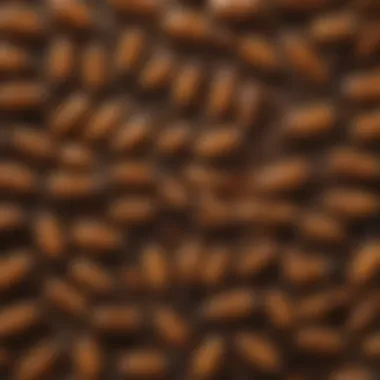

Mating Rituals
Mating rituals among reproductive termites depict intricate behaviors and interactions that facilitate the pairing process and ensure reproductive success. The key characteristic of mating rituals lies in their role in reinforcing social bonds, establishing hierarchies, and determining mating outcomes within the colony. This unique feature ensures compatibility among mates and promotes genetic diversity essential for colony vitality and longevity. While beneficial in fostering reproductive connections, mating rituals may also be influenced by external factors such as competition or resource availability, impacting mate selection and overall reproductive efficiency.
Colony Dynamics and Reproductive Strategy
Succession Planning
Replacement of Reproductive Pairs
In the realm of termite colonies, the replacement of reproductive pairs stands out as a fundamental aspect crucial for ensuring the long-term viability and success of the colony. This process involves the identification and replacement of aged or inefficient reproductive individuals with younger, more vigorous ones. The key characteristic of this mechanism lies in its ability to maintain genetic diversity and vitality within the colony effectively, contributing significantly to the overall reproductive health and longevity. The unique feature of replacement of reproductive pairs is its adaptive nature, ensuring that the colony remains resilient and adaptive to environmental changes. While advantages include fostering genetic resilience and adaptability, potential disadvantages may stem from potential disruptions to existing hierarchies and social structures within the colony.
Long-term Colony Viability
Long-term colony viability plays a critical role in sustaining the continuity and prosperity of termite colonies over extended periods. This aspect focuses on strategies and practices that promote the colony's endurance and productivity across generations. The key characteristic of long-term colony viability lies in its capacity to enhance the adaptability and resilience of the colony to various stressors and challenges, thus ensuring its survival and growth. Its distinct feature involves the continuous assessment and refinement of colony dynamics to optimize resource utilization and reproductive success. Advantages of prioritizing long-term colony viability include securing the colony's lineage and genetic diversity while closely monitoring potential threats and instabilities that could jeopardize its sustainability. However, challenges may arise from balancing immediate needs with long-term strategies, necessitating careful planning and implementation.
Reproductive Supremacy
Maintaining Dominance
The concept of maintaining dominance within a termite colony revolves around the strategic control and regulation of reproductive behaviors among members. This aspect plays a crucial role in preserving hierarchical structures and ensuring the stability and efficiency of reproductive processes. The key characteristic of maintaining dominance lies in its ability to prevent conflicts and disruptions that may arise from intra-colony competitions for reproductive opportunities. It serves as a beneficial choice for this article by highlighting the significance of social order and cooperative reproductive behaviors within termite societies. The unique feature of maintaining dominance is its role in maintaining harmony and order, thereby maximizing reproductive success and genetic propagation while minimizing internal conflicts. While advantages include fostering cooperation and cohesion, potential disadvantages may surface in situations where dominant individuals become overly controlling or suppressive, impacting genetic diversity and overall colony health.
Genetic Lineage Preservation
Genetic lineage preservation represents a fundamental aspect of reproductive supremacy within termite colonies, emphasizing the conservation and enhancement of genetic heritage across generations. This element focuses on strategies and mechanisms that safeguard the purity and integrity of genetic lineages within the colony. The key characteristic of genetic lineage preservation lies in its capacity to maintain genetic diversity and resilience, thereby enriching the colony's adaptive potential and longevity. Its unique feature involves the promotion of selective breeding and mating practices that aim to preserve desirable genetic traits and minimize potential genetic bottlenecks. Advantages of genetic lineage preservation include the preservation of beneficial genetic variations and the mitigation of genetic disorders or weaknesses that could compromise colony fitness. However, challenges may arise from limited genetic variability and the potential emergence of inbreeding effects, necessitating a balanced approach towards genetic management and conservation.
Conclusion
Reproductive termites play a pivotal role in the intricate dynamics of termite colonies, serving as the driving force behind colony growth and sustainability. The significance of reproductive termites within the termite society cannot be understated. By delving into their world, we gain a deeper understanding of how these termites shape the very foundation of termite colonies, ensuring their continuity and success. It is essential to recognize the crucial part that reproductive termites play in maintaining the balance within termite colonies.
Significance of Reproductive Termites
Key role in termite colonies
Reproductive termites hold a key role within termite colonies by perpetuating the colony through their ability to reproduce. The proliferation of new termites ensures the longevity and expansion of the colony, contributing to its stability and growth. Their dedicated task of reproduction ensures the continuity of the colony lineage, preserving its genetic diversity and enhancing its resilience against environmental challenges. This key role in termite colonies is fundamental to the overall sustainability and evolution of the termite society within the ecosystem.
Contributions to ecosystem balance
The contributions of reproductive termites to ecosystem balance are multifaceted. By facilitating the growth and survival of termite colonies, they indirectly impact the larger ecosystem by regulating soil composition, nutrient cycling, and plant decomposition. Their activities influence the biodiversity and ecological dynamics of their habitat, creating a ripple effect that extends beyond the confines of the termite mound. The intricate interactions of reproductive termites with their environment showcase their critical role in maintaining ecosystem equilibrium and functionality.
Continued Research
Further exploration opportunities
Further exploration opportunities in understanding reproductive termites present exciting prospects for expanding our knowledge of termite behavior and biology. Investigating their reproductive mechanisms, genetic interactions, and social structures can offer valuable insights into their evolutionary adaptations and ecological significance. By embarking on in-depth studies of their behaviors and interactions, we can unravel the complexities of termite societies and their broader ecological implications, paving the way for enhanced conservation strategies and ecosystem management practices.
Impact on pest control strategies
The impact of reproductive termites on pest control strategies underscores the need for innovative approaches to mitigate termite infestations sustainably. Understanding their reproductive patterns and colony dynamics is essential for developing targeted pest management techniques that harness the natural behaviors of termites. By leveraging insights from reproductive termite research, pest control experts can devise more effective and eco-friendly solutions to address termite challenges, emphasizing the importance of integrating scientific findings into practical applications for pest management.


